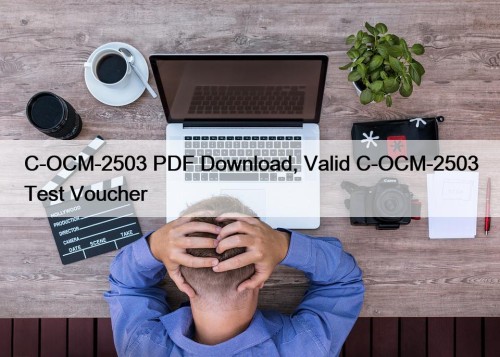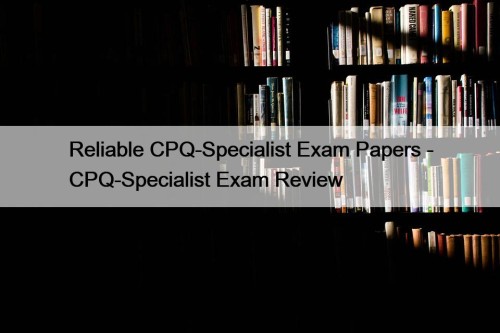Most Popular
 C-OCM-2503 PDF Download, Valid C-OCM-2503 Test Voucher
C-OCM-2503 PDF Download, Valid C-OCM-2503 Test Voucher
As you know, the low-quality latest C-OCM-2503 exam torrent may ...
 Free PDF Quiz C-BW4H-2404 - SAP Certified Associate - Data Engineer - Data Fabric–Valid New Test Materials
Free PDF Quiz C-BW4H-2404 - SAP Certified Associate - Data Engineer - Data Fabric–Valid New Test Materials
Prep4pass provides proprietary preparation guides for the certification exam offered ...
 Reliable CPQ-Specialist Exam Papers - CPQ-Specialist Exam Review
Reliable CPQ-Specialist Exam Papers - CPQ-Specialist Exam Review
What's more, part of that DumpsTests CPQ-Specialist dumps now are ...



C-OCM-2503 PDF Download, Valid C-OCM-2503 Test Voucher

As you know, the low-quality latest C-OCM-2503 exam torrent may do harmful influence on you which may causes results past redemption. Whether you have experienced that problem or not was history by now. The free demos do honor to the perfection of our latest C-OCM-2503 exam torrent, and also a performance of our considerate after sales services. Those demos serve as epitomes of real C-OCM-2503 Quiz guides for your reference. In our demos, some examples or question points were enumerated as some representatives of our C-OCM-2503 test prep. How convenient and awesome of it!
SAP C-OCM-2503 Exam Syllabus Topics:
| Topic | Details |
|---|---|
| Topic 1 |
|
| Topic 2 |
|
| Topic 3 |
|
| Topic 4 |
|
| Topic 5 |
|
| Topic 6 |
|
All C-OCM-2503 Dumps and SAP Certified Associate - Organizational Change Management Training Courses Help candidates to study and pass the SAP Certified Associate - Organizational Change Management Exams hassle-free!
As you know the registration fee for the SAP Certified Associate - Organizational Change Management (C-OCM-2503) certification exam is itself very high, varying between $100 and $1000. And after paying the registration fee for better preparation a candidate needs budget-friendly and reliable SAP Certified Associate - Organizational Change Management (C-OCM-2503) pdf questions. That is why PassReview has compiled the most reliable updated C-OCM-2503 Exam Questions with up to 1 year of free updates. The SAP C-OCM-2503 practice test can be used right after being bought by the customer and they can avail of the benefits given in the SAP Certified Associate - Organizational Change Management (C-OCM-2503) pdf questions.
SAP Certified Associate - Organizational Change Management Sample Questions (Q70-Q75):
NEW QUESTION # 70
What are success factors for the different dimensions of the change management framework? Note: There are
3 correct answers to this question.
- A. Regarding change communication, it is important to develop a compelling, comprehensive change story.
- B. Regarding change realization, it is important to actively support the business units in the development of a new operating model.
- C. Regarding change leadership, it is important to establish stakeholder management as an ongoing activity.
- D. Regarding change effectiveness, it is important to use a balanced combination of change effectiveness measures.
- E. Regarding change strategy, it is important to fulfill the expectations towards change management.
Answer: B,C,D
Explanation:
SAP's OCM framework includes dimensions like realization, leadership, and effectiveness. Option A is correct because change realization involves supporting business units to adopt new models post- implementation. Option C is correct as change leadership requires ongoing stakeholder management to sustain support. Option D is correct because effectiveness relies on diverse metrics (e.g., adoption rates, satisfaction) to assess impact. Option B is vague and not a specific success factor-meeting expectations is an outcome, not a driver. Option E, while important, is a communication tactic, not a framework-wide success factor.
Extract from SAP OCM Concepts: Success factors in SAP OCM include support for realization, continuous leadership, and robust effectiveness measures (SAP OCM Framework).
NEW QUESTION # 71
What are the key target groups of the learning needs analysis of an SAP project?
- A. Project team and business users
- B. Managers and employees
- C. Business users and suppliers
- D. IT team and software providers
Answer: A
Explanation:
The learning needs analysis (LNA) in an SAP project identifies training requirements for those directly involved or impacted. Option D is correct because the project team (e.g., implementers) and business users (e.
g., end-users) are the primary groups needing enablement to execute and adopt the solution. Option A is too broad-managers and employees include non-users. Option B is incorrect; software providers are external and not typically trained. Option C is incorrect-suppliers are not primary targets for internal system training.
Extract from SAP OCM Concepts: The LNA targets project team and business users to ensure effective enablement (SAP Activate, Enablement Workstream).
NEW QUESTION # 72
What should a change manager make clear to avoid being held responsible for handling all people-related issues within the cloud project? Note: There are 3 correct answers to this question.
- A. Change management is a team sport, requiring the commitment and engagement of the entire project team
- B. Change management is a checkbox approach, requiring all stakeholders to strictly follow predefined procedures
- C. Change management is a long-distance endeavor, requiring a continuous joint effort throughout the project
- D. Change management is a project management task, requiring the project lead to apply tools and templates provided by the change manager
- E. Change management is a core leadership task, requiring the active involvement and support of the business
Answer: A,C,E
Explanation:
The change manager in SAP OCM must set boundaries to avoid being the sole "people fixer." Option A is correct-describing OCM as a "long-distance endeavor" with joint effort clarifies it's an ongoing, collective process (e.g., spanning Prepare to Run), not a solo fix-it role. For instance, adoption issues in Run require sustained teamwork, not just the change manager's intervention. Option B is correct because calling it a "team sport" emphasizes that the project team-PM, IT, business-shares responsibility (e.g., PM schedules, IT supports, OCM guides), preventing the change manager from being overburdened. Option D is correct as framing OCM as a "core leadership task" highlights that business leaders must drive buy-in (e.g., a VP addressing resistance), not just delegate to the change manager.
Option C is incorrect-OCM isn't a project management task; it's a distinct discipline collaborating with PM, not subsumed under it. Option E is incorrect; a "checkbox approach" misrepresents OCM's dynamic, adaptive nature-strict procedures don't fit SAP's agile methodology. SAP OCM stresses shared ownership to manage expectations.
"Clarify that change management is a continuous, team-based effort requiring leadership support, not a solitary or rigid task, to define its scope accurately" (SAP OCM Framework, Change Manager Role Clarification).
NEW QUESTION # 73
How do you define the term Organizational Change Management?
- A. It is a comprehensive, cyclic, and structured approach for transitioning individuals, groups, andorganizations from a traditional to an agile organizational set-up with focus on the added value for the impacted users.
- B. It is a comprehensive, cyclic, and structured approach for transitioning individuals, groups, and organizations from a current to a future state with intended business benefits.
- C. It is a selective, singular, and intuitive approach for transitioning individuals, groups, and organizations from a current to a future state with focus on the added value for the impacted users.
- D. It is a selective, singular, and intuitive approach for transitioning individuals, groups, and organizations from a traditional to an agile organizational setup with intended business benefits.
Answer: B
Explanation:
SAP defines OCM broadly and systematically. Option C is correct because it describes OCM as comprehensive (holistic), cyclic (iterative), and structured (methodical), transitioning from current to future states with business benefits-aligning with SAP Activate's goals. Option A is incorrect-"selective" and
"intuitive" contradict OCM's structured nature. Option B narrows it to "agile setup," which isn't SAP- specific. Option D is incorrect due to "selective" and "singular," missing the cyclic aspect. C reflects SAP's OCM essence.
"Organizational Change Management is a comprehensive, cyclic, and structured approach to transition individuals, groups, and organizations from a current to a future state, delivering intended business benefits" (SAP OCM Framework, Definition).
NEW QUESTION # 74
Which responsibilities regarding change communication activities should be clearly assigned in a communication plan? Note: There are 2 correct answers to this question.
- A. Content assessment and content archiving
- B. Content creation and content review
- C. Content alignment and content evaluation
- D. Content approval and content delivery
Answer: B
Explanation:
A communication plan in SAP OCM defines roles to ensure smooth execution of change communication.
Option B is correct because content creation (e.g., drafting newsletters by a change manager) and content review (e.g., checking accuracy by a business lead) are critical responsibilities that must be assigned to avoid delays or errors. Creation involves generating messages (e.g., "Why we're moving to the cloud"), while review ensures alignment with project goals and stakeholder needs (e.g., confirming technical terms are clear). Clear assignment prevents overlap or gaps-imagine a scenario where no one knows who's drafting the go-live announcement, causing confusion.
Option A is incorrect-content approval (final sign-off, often by leadership) is distinct from review and less operational, while delivery (e.g., sending emails) is logistical, often handled by tools or admins, not a core creative responsibility. Option C is incorrect; content assessment (evaluating effectiveness) is post-delivery analysis, and archiving is administrative, not plan-specific. Option D is incorrect-content alignment (ensuring consistency) is part of review, and evaluation overlaps with assessment, neither requiring separate assignment. SAP OCM focuses on creation and review as foundational tasks.
"The communication plan assigns responsibilities for content creation and review to ensure messages are developed and validated effectively" (SAP Activate, Communication Plan Structure).
NEW QUESTION # 75
......
With the high pass rate as 98% to 100%, we are confident to claim that our high quality and high efficiency of our C-OCM-2503 exam guide is unparalleled in the market. We provide the latest and exact C-OCM-2503 practice quiz to our customers and you will be grateful if you choose our C-OCM-2503 Study Materials and gain what you are expecting in the shortest time. Besides, you have the chance to experience the real exam in advance with the Software version of our C-OCM-2503 practice materials.
Valid C-OCM-2503 Test Voucher: https://www.passreview.com/C-OCM-2503_exam-braindumps.html
- Pass Guaranteed 2025 Efficient C-OCM-2503: SAP Certified Associate - Organizational Change Management PDF Download ⬛ Search for ✔ C-OCM-2503 ️✔️ and obtain a free download on 【 www.prep4away.com 】 🤏Braindumps C-OCM-2503 Torrent
- Exam C-OCM-2503 Pass4sure 🌿 Braindumps C-OCM-2503 Torrent 🔤 High C-OCM-2503 Quality 👋 Go to website ⇛ www.pdfvce.com ⇚ open and search for ⏩ C-OCM-2503 ⏪ to download for free 🕜Test C-OCM-2503 Simulator Free
- Actual SAP C-OCM-2503 Exam Dumps – Pass Exam With Good Scores 🕎 Easily obtain ⏩ C-OCM-2503 ⏪ for free download through { www.pdfdumps.com } ➰New C-OCM-2503 Exam Pass4sure
- 2025 SAP Fantastic C-OCM-2503: SAP Certified Associate - Organizational Change Management PDF Download 🧔 Search for ➠ C-OCM-2503 🠰 and obtain a free download on ➥ www.pdfvce.com 🡄 📠Dumps C-OCM-2503 Questions
- Actual SAP C-OCM-2503 Exam Dumps – Pass Exam With Good Scores 🐺 Search for ▛ C-OCM-2503 ▟ and obtain a free download on ▛ www.free4dump.com ▟ 🗾C-OCM-2503 Pass Test Guide
- Test C-OCM-2503 Simulator Free 🦎 Practice C-OCM-2503 Online 🔪 Exam C-OCM-2503 Simulator Free 🧹 Download ➠ C-OCM-2503 🠰 for free by simply entering ▶ www.pdfvce.com ◀ website ⚾Test C-OCM-2503 Questions Answers
- C-OCM-2503 Reliable Test Cram 🥧 High C-OCM-2503 Quality 🟧 Exam C-OCM-2503 Simulator Free 🐟 Search for 《 C-OCM-2503 》 on 「 www.dumpsquestion.com 」 immediately to obtain a free download 🍡C-OCM-2503 Pass Test Guide
- Does SAP C-OCM-2503 Certification Help you Polish your Skills? ⏹ Search on { www.pdfvce.com } for [ C-OCM-2503 ] to obtain exam materials for free download ☔Dumps C-OCM-2503 Questions
- Pass Guaranteed 2025 Efficient C-OCM-2503: SAP Certified Associate - Organizational Change Management PDF Download 🤲 Immediately open ⏩ www.getvalidtest.com ⏪ and search for ➽ C-OCM-2503 🢪 to obtain a free download 🟫New C-OCM-2503 Test Discount
- Actual SAP C-OCM-2503 Exam Dumps – Pass Exam With Good Scores 🆗 The page for free download of { C-OCM-2503 } on ( www.pdfvce.com ) will open immediately 🆘C-OCM-2503 Exam Certification Cost
- 2025 SAP C-OCM-2503 –Professional PDF Download ⌨ Open website ➡ www.pass4leader.com ️⬅️ and search for “ C-OCM-2503 ” for free download ⏯Test C-OCM-2503 Simulator Free
- C-OCM-2503 Exam Questions
- jackfox233.stuffdirectory.com techwitsclan.com kuhenan.com procoderacademy.com rabonystudywork.com hd.jzxinxiwang.cn learn.educatingeverywhere.com launchpad.net.in learn.hedgex.in nailitprivatecourses.com
Tags: C-OCM-2503 PDF Download, Valid C-OCM-2503 Test Voucher, C-OCM-2503 Real Exam Questions, C-OCM-2503 Valid Mock Test, C-OCM-2503 Pdf Version